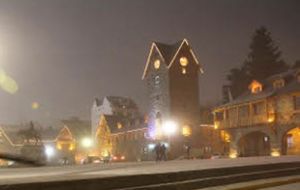MercoPress. South Atlantic News Agency
South Chile volcano eruption prompts evacuation; covers Argentine province with ash
 Bariloche went dark and was covered with volcanic ash
Bariloche went dark and was covered with volcanic ash Southern Chile's Puyehue volcano erupted on Saturday for the first time in half a century prompting evacuation orders for 3,500 people and turning into dark the Argentine Patagonian resort of San Carlos de Bariloche, 100 kilometres to the east as it was covered with ash.
Chile’s National Service of Geology and Mining said the explosion that sparked the eruption also produced a column of gas 10 kilometres high, hours after warning of strong seismic activity in the area.
”You can see the fire (in the volcano) and a plume of smoke, and there's a strong smell of sulphur,“ top Los Rios region official Juan Andres Varas told reporters.
The Chilean government ordered the evacuation of 3.500 peopleto be relocated to shelters in safe areas. Authorities issued a red alert, the maximum warning level, for the area. A border crossing between Argentina and Chile was closed.
In Argentina Bariloche authorities told the population to remain calm, to keep their water reserves at hand and to remain inside their homes at all times in order to avoid the falling ash. In case of an emergency, officials have suggested the use of face masks.
After a red alert was declared, Bariloche authorities shut down the airport. Firemen also asked the population to seal all windows and take their cars into their garages. The ash cloud is expected to expand all over the Patagonia Río Negro and Chubut provinces as prevailing winds blow the ashes east and south.
”We're trying to stop car traffic and ask that people stay at home and close their doors and windows to prevent the volcanic ash from coming in. The city's airport was also closed,“ Carlos Hidalgo, Bariloche's communications secretary, told TN television.
”Ash was dumped like a snowstorm... The city is covered in grey ash.”
Nearby localities were also affected, said Hidalgo, whose city of 50,000 people welcomes thousands of foreign tourists each year to its lakes and mountain scenery.
Puyehue is located 870 kilometres south of Santiago in the Cordon Caulle complex nestled in the Andes Mountains. Its last major eruption was in 1960, following a magnitude 9.5 earthquake.
Earlier, five quakes ranging between 4.6 and 4.8 in the Richter scale had been registered in the south of the Argentine Neuquén province. The quakes’ epicentre was located near the town of Villa La Angostura, and they all took place between late Friday and Saturday, local Río Negro newspaper assured.
It was not immediately clear which of the chain's four volcanoes had erupted because of ash cover and weather conditions. The chain last saw a major eruption in 1960. Local media said the smell of sulfur hung in the air and there was constant seismic activity.
Chile's chain of about 2,000 volcanoes or ‘ring fire’ is the world's second largest after Indonesia. Some 50 to 60 are on record as having erupted, and 500 are potentially active.





Top Comments
Disclaimer & comment rules-

Read all commentsmay one suggest you vacate the place very quickly, before the biggy ?
Jun 05th, 2011 - 07:26 pm 0Commenting for this story is now closed.
If you have a Facebook account, become a fan and comment on our Facebook Page!